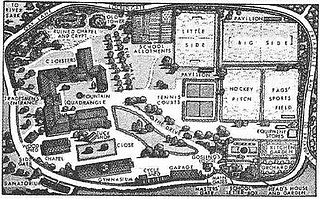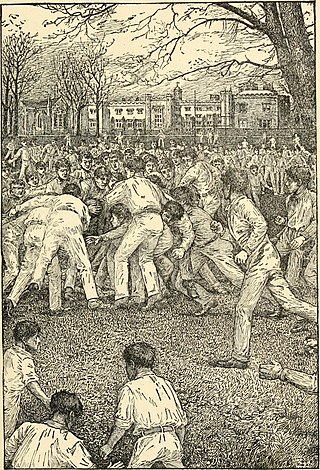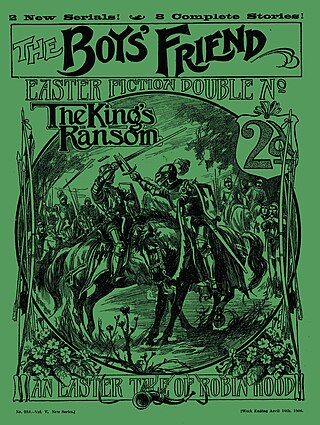
Greyfriars School is a fictional English public school used as a setting in the long-running series of stories by the writer Charles Hamilton, who wrote under the pen-name of Frank Richards. Although the stories are focused on the Remove, whose most famous pupil was Billy Bunter, other characters also featured on a regular basis.

Charles Harold St. John Hamilton was an English writer, specialising in writing long-running series of stories for weekly magazines about recurrent casts of characters, his most frequent and famous genre being boys' public school stories, though he also wrote in other genres. He used a variety of pen-names, generally using a different name for each set of characters he wrote about, the most famous being Frank Richards for the Greyfriars School stories featuring Billy Bunter. Other important pen-names included Martin Clifford, Owen Conquest and Ralph Redway. He also wrote hundreds of stories under his real name such as the Ken King stories for The Modern Boy.

William George Bunter is a fictional schoolboy created by Charles Hamilton using the pen name Frank Richards. He features in stories set at Greyfriars School, a fictional English public school in Kent, originally published in the boys' weekly story paper The Magnet from 1908 to 1940. The character has appeared in novels, on television, in stage plays and in comic strips.

The Magnet was a British weekly boys' story paper published by Amalgamated Press. It ran from 1908 to 1940, publishing a total of 1,683 issues.

The school story is a fiction genre centring on older pre-adolescent and adolescent school life, at its most popular in the first half of the twentieth century. While examples do exist in other countries, it is most commonly set in English boarding schools and mostly written in girls' and boys' subgenres, reflecting the single-sex education typical until the 1950s. It focuses largely on friendship, honour and loyalty between pupils. Plots involving sports events, bullies, secrets, rivalry and bravery are often used to shape the school story.

Tom Merry is the principal character in the "St Jim's" stories which appeared in the boy's weekly paper, The Gem, from 1907 to 1939. The stories were all written using the pen-name of Martin Clifford, the majority by Charles Hamilton who was more widely known as Frank Richards, the creator of Billy Bunter.
Story Paper Collectors' Digest was a journal published from November 1946 until May 2005, and with special intermittent issues continuing on until late 2007. It was created by Herbert Leckenby. With articles on story papers, it heavily featured the work of Charles Hamilton, Edwy Searles Brooks and the tales of detectives Sexton Blake and Nelson Lee. It was published monthly until 2004. The editors were Herbert Leckenby until his death in October 1959, then Eric Fayne until January 1987 when he retired as editor, then Mary Cadogan.
Elizabeth Gertrude Bunter, better known as Bessie Bunter, is a fictional character created by Charles Hamilton, who also created her more famous brother Billy Bunter.

Charles Henry Chapman (1879–1972), who signed his work as C. H. Chapman, was a British illustrator and cartoonist best known for his work in boys' story papers such as The Magnet where the character Billy Bunter appeared. He later illustrated Bunter cartoon strips and several Bunter books published in the 1950s and 1960s.

Magazines intended for boys fall into one of three classifications. These are comics which tell the story by means of strip cartoons; story papers which have several short stories; and pulp magazines which have a single, but complete, novella in them. The latter were not for the younger child and were often detective or western in content and were generally greater in cost. Several titles were published monthly whereas the other two categories were more frequent.

The Boys' Friend was a British story paper of the early 20th century, published by Amalgamated Press from 1895 to 1927.
"Boys' Weeklies" is an essay by George Orwell in which he analyses those weekly story-paper publications for boys which were current around 1940. After being published in Horizon in abridged form, it was published alongside two of his other pieces in Inside the Whale and Other Essays from Victor Gollancz Ltd.
The Schoolgirl was a British weekly story paper aimed at girls. Published by Amalgamated Press (AP), The Schoolgirl ran in two series, the first from 1922 to 1923, and the second from 1929 to 1940.
The Schoolgirls' Own was a British weekly story paper aimed at girls. Published by Amalgamated Press, it was launched in February 1921 and ran for 798 issues until May 1936, when it was merged with a sister publication.

The Secret Seven series is an 11 part series of stories published in The Magnet magazine in 1934. The author was prolific writer Charles Hamilton, writing under the pen name Frank Richards. The series was republished by the Howard Baker as two volumes of Magnet facsimile editions in 1976.

Billy Bunter of Greyfriars School is a BBC Television show broadcast from 1952 to 1961. It was based on the Greyfriars School stories, written by author Charles Hamilton under the pen name Frank Richards. Hamilton wrote all of the scripts for the television show.

Billy Bunter of Greyfriars School is a school story by Charles Hamilton writing as Frank Richards, using the characters and settings of the Greyfriars School stories published from 1908 to 1940 in The Magnet. The retail price was 5 shillings.
School Friend was the name of two different British weekly publications marketed toward girls, both of which were pioneering in their respective categories. The first School Friend, published from 1919 to 1929, was the first story paper marketed exclusively to girls. The second School Friend, published from 1950 to 1965, is considered the first British girls' comic. Although both published by Amalgamated Press, and both marketed toward girls, the content of the two publications was not directly related.












